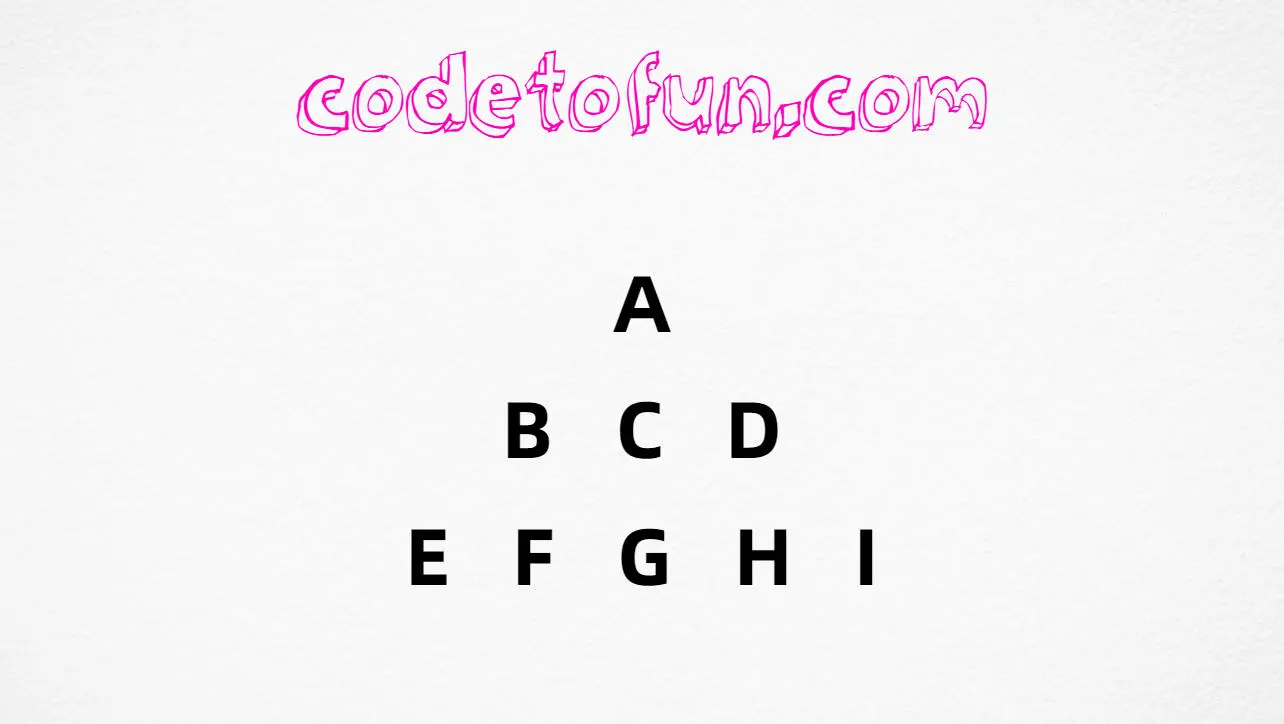
C Topics
- C Intro
- C Control Statement
- C Control Loops
- C String Functions
- C Math Functions
- C Header Files
- C Interview Programs
- C Star Pattern
- C Number Pattern
- C Alphabet Pattern
- Alphabet Pattern 1
- Alphabet Pattern 2
- Alphabet Pattern 3
- Alphabet Pattern 4
- Alphabet Pattern 5
- Alphabet Pattern 6
- Alphabet Pattern 7
- Alphabet Pattern 8
- Alphabet Pattern 9
- Alphabet Pattern 10
- Alphabet Pattern 11
- Alphabet Pattern 12
- Alphabet Pattern 13
- Alphabet Pattern 14
- Alphabet Pattern 15
- Alphabet Pattern 16
- Alphabet Pattern 17
- Alphabet Pattern 18
- Alphabet Pattern 19
- Alphabet Pattern 20
- Alphabet Pattern 21
- Alphabet Pattern 22
- Alphabet Pattern 23
- Alphabet Pattern 24
- Alphabet Pattern 25
- Alphabet Pattern 26
- Alphabet Pattern 27
- Alphabet Pattern 28
- Alphabet Pattern 29
- Alphabet Pattern 30
- Alphabet Pattern 31
- Alphabet Pattern 32
- Alphabet Pattern 33
- Alphabet Pattern 34
C Alphabet Pattern 16

Photo Credit to CodeToFun
C Alphabet Pattern 16
Here`s a program that prints the above alphabet pattern using C Programming:
#include <stdio.h>
int main() {
int i, j, k;
k = 65;
for (i = 65; i <= 69; i += 2) {
for (j = 69; j >= 65; j--) {
if (j > i)
printf(" ");
else
printf("%c ", k++);
}
printf("\n");
}
return 0;
}💻 Testing the Program
When you run the above program, it will print the following output:
A B C D E F G H I
🧠 How the Program Works
Let's break down the logic behind the code:
- The program begins with the inclusion of the <stdio.h> header file for input and output operations.
- The main() function is declared.
- Inside the main() function, we declare variables i, j, and k as integers. k is initialized with the ASCII value of 'A', which is 65.
- The outer loop runs from 65 to 69 (corresponding to ASCII values of 'A' to 'E') with a step size of 2.
- Within the outer loop, the inner loop is used to print the characters and spaces. It runs from 69 to 65 (corresponding to ASCII values of 'E' to 'A').
- In each iteration of the inner loop, an if statement is used to check if the current value of j is greater than the current value of i. If j is greater, a space character is printed. Otherwise, the character represented by the current value of k is printed, followed by a space. The value of k is then incremented.
- After printing the characters and spaces in the inner loop for each row, a newline character (\n) is printed to move to the next line.
- The outer loop continues until i reaches the value of 69, printing the desired pattern.
- The program ends with the return 0; statement.
The program uses nested loops to print a pattern where each row contains a sequence of characters with increasing count and is preceded by spaces. The characters are taken from the ASCII values 'A' to 'E', and the spaces are inserted based on the difference between the current column and the row number.
I hope this explanation clarifies the code and helps you understand how the pattern is generated in the provided C program.
💯 Tips for Enhancement:
Explore the versatility of this pattern by adjusting its parameters. Whether you increase or decrease the size, tweak the spacing, or modify the characters used, each change opens up a world of possibilities, allowing you to customize and create your unique visual effects.
✔ Conclusion:
Creating visually appealing patterns is not only a fun endeavour but also a great way to enhance your programming or design skills. We hope this tutorial has inspired you to explore the world of creative coding. Share your creations with us, and let your imagination run wild!
🤗 Closing Call-to-Action:
We'd love to see your unique interpretations of the alphabet pattern. Share your creations in the comments below, and don't hesitate to reach out if you have any questions or suggestions for future tutorials. Happy coding!
👨💻 Join our Community:
Author

For over eight years, I worked as a full-stack web developer. Now, I have chosen my profession as a full-time blogger at codetofun.com.
Buy me a coffee to make codetofun.com free for everyone.
Buy me a Coffee












If you have any doubts regarding this article (C Alphabet Pattern 16) please comment here. I will help you immediately.